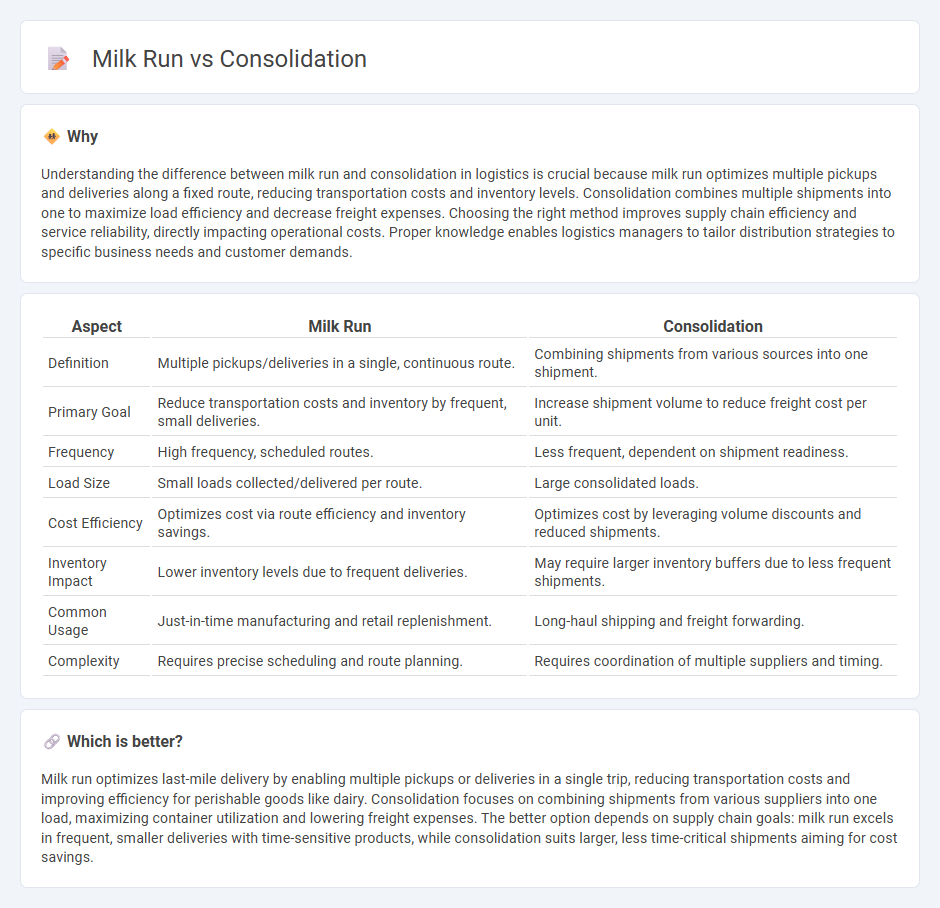
Milk run logistics involves scheduled, fixed-route collection of smaller shipments from multiple suppliers to optimize transportation efficiency and reduce costs. Consolidation in logistics aggregates shipments from various origins or vendors into a single, larger load to maximize container or truck space, improving load utilization and supply chain efficiency. Explore in-depth insights into how milk run and consolidation strategies transform supply chain management and enhance logistics performance.
Why it is important
Understanding the difference between milk run and consolidation in logistics is crucial because milk run optimizes multiple pickups and deliveries along a fixed route, reducing transportation costs and inventory levels. Consolidation combines multiple shipments into one to maximize load efficiency and decrease freight expenses. Choosing the right method improves supply chain efficiency and service reliability, directly impacting operational costs. Proper knowledge enables logistics managers to tailor distribution strategies to specific business needs and customer demands.
Comparison Table
| Aspect | Milk Run | Consolidation |
|---|---|---|
| Definition | Multiple pickups/deliveries in a single, continuous route. | Combining shipments from various sources into one shipment. |
| Primary Goal | Reduce transportation costs and inventory by frequent, small deliveries. | Increase shipment volume to reduce freight cost per unit. |
| Frequency | High frequency, scheduled routes. | Less frequent, dependent on shipment readiness. |
| Load Size | Small loads collected/delivered per route. | Large consolidated loads. |
| Cost Efficiency | Optimizes cost via route efficiency and inventory savings. | Optimizes cost by leveraging volume discounts and reduced shipments. |
| Inventory Impact | Lower inventory levels due to frequent deliveries. | May require larger inventory buffers due to less frequent shipments. |
| Common Usage | Just-in-time manufacturing and retail replenishment. | Long-haul shipping and freight forwarding. |
| Complexity | Requires precise scheduling and route planning. | Requires coordination of multiple suppliers and timing. |
Which is better?
Milk run optimizes last-mile delivery by enabling multiple pickups or deliveries in a single trip, reducing transportation costs and improving efficiency for perishable goods like dairy. Consolidation focuses on combining shipments from various suppliers into one load, maximizing container utilization and lowering freight expenses. The better option depends on supply chain goals: milk run excels in frequent, smaller deliveries with time-sensitive products, while consolidation suits larger, less time-critical shipments aiming for cost savings.
Connection
Milk run and consolidation are interconnected supply chain strategies that optimize transportation efficiency by combining multiple supplier shipments into a single, consolidated load. This method reduces transportation costs and minimizes carbon emissions by maximizing vehicle utilization and streamlining delivery routes. Effective consolidation through milk run logistics enhances inventory management and improves overall supply chain responsiveness.
Key Terms
Load Optimization
Load optimization in consolidation involves combining multiple shipments from various suppliers into a single transport unit to maximize space utilization and reduce costs. Milk run logistics schedules frequent, repetitive pickups from several suppliers within a designated area, minimizing transport distances and inventory levels while improving delivery reliability. Explore more to understand how these strategies can transform your supply chain efficiency and cost savings.
Route Planning
Consolidation in route planning involves combining multiple shipments from various suppliers into a single delivery to minimize transportation costs and improve efficiency. Milk run strategy optimizes route planning by scheduling vehicles to visit multiple suppliers or customers in a loop, ensuring timely pickups and deliveries while reducing empty miles. Explore detailed advantages and implementation techniques to master effective route planning for your supply chain.
Shipment Frequency
Consolidation reduces shipping costs by combining multiple smaller shipments into one larger load, often resulting in less frequent shipments. Milk run logistics optimize frequent, scheduled pickups and deliveries, ensuring consistent shipment frequency and improved inventory flow. Explore how shipment frequency impacts your supply chain efficiency with these two strategies.
Source and External Links
Consolidation (business) - Wikipedia - Consolidation in business refers to the merger and acquisition of many smaller companies into a few much larger ones, often creating a new entity with combined resources and financial statements.
CONSOLIDATION definition | Cambridge English Dictionary - Consolidation is the process of joining together businesses to form a single organization or making something stronger and more unified.
CONSOLIDATION Definition & Meaning - Dictionary.com - Consolidation is the act or instance of combining into a single or unified whole, resulting in unification and increased strength.
 dowidth.com
dowidth.com